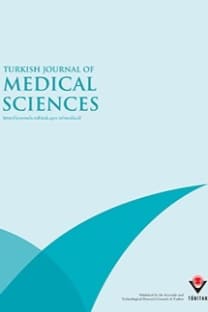An investigation of the bactericidal activity of chlorhexidine digluconateagainst multidrug-resistant hospital isolates
An investigation of the bactericidal activity of chlorhexidine digluconateagainst multidrug-resistant hospital isolates
___
- 1. European Union Biocidal Products Regulation. EU Biocides Regulation 528/2012. Health and Safety Executive. Biocides. Brussels, Belgium: EU; 2012.
- 2. McDonnell G, Russell AD. Antiseptics and disinfectants: activity, action, and resistance. Clin Microbiol Rev 1999; 12: 147179.
- 3. Russell AD. Biocide usage and antibiotic resistance: the relevance of laboratory findings to clinical and environmental situations. Lancet Infect Dis 2003; 3:794803.
- 4. Horner C, Mawer D, Wilcox M. Reduced susceptibility to chlorhexidine in staphylocci: is it increasing and does it matter? J Antimicrob Chemother 2012; 67: 25472559.
- 5. Maillard JY. Bacterial resistance to biocides in the healthcare environment: should it be of genuine concern? J Hosp Infect 2007; 65: 6072.
- 6. Russell AD. Bacterial resistance to disinfectants: present knowledge and future problems. J Hosp Infect 1998; 43 (Suppl.): S57S68.
- 7. Harbarth S, Soh Tuan S, Horner C, Wilcox MH. Is reduced susceptibility to disinfectants and antiseptics a risk in healthcare settings? A point/counterpoint review. J Hosp Infect 2014; 87: 194202.
- 8. McBain AJ, Gilbert P. Biocide tolerance and harbingers of doom. Int Biodeter Biodegr 2001; 47: 5561.
- 9. Shiraishi T, Nakagawa Y. Review of disinfectant susceptibility of bacteria isolated in hospital to commonly used disinfectants. Postgrad Med J 1993; 69 (Suppl. 3): S7077.
- 10. Vali L, Davies SE, Lai LLG, Dave J, Amyes SGB. Frequency of biocide resistance genes, antibiotic resistance and the effect of chlorhexidine exposure on clinical methicillin-resistant Staphylococcus aureus isolates. J Antimicrob Chemother 2008; 61: 524532.
- 11. Clinical and Laboratory Standards Institute. Methods for Dilution Antimicrobial Susceptibility Tests for Bacteria that Grow Aerobically: Approved Standard. M07-A8. 8th ed. Wayne, PA, USA: Clinical and Laboratory Standards Institute; 2008.
- 12. European Committee for Standardization. EN 1040, Chemical Disinfectants and Antiseptics - Quantitative Suspension Test for the Evaluation of Basic Bactericidal Activity of Chemical Disinfectants and Antiseptics - Test Method and Requirements. (Phase 1). Brussels, Belgium: European Committee for Standardization; 2005.
- 13. Ekizoğlu MT, Özalp M, Sultan N, Gür D. An investigation of the bactericidal effect of certain antiseptic/disinfectants against isolates of gram-negative bacteria. Infect Cont Hosp Epidemiol 2003; 24: 225227.
- 14. Reybrouck G. Efficacy of inactivators against 14 disinfectant substances. Zbl Bakt Hyg I Abt Orig B 1979; 168: 480492.
- 15. Kung HC, Hoyert DL, Xu J, Murphy SL. Deaths: final data for 2005. Natl Vital Stat Rep 2008; 56: 1120.
- 16. Metintas S, Akgun Y, Durmaz G, Kalyoncu C. Prevalence and characteristics of nosocomial infections in a Turkish university hospital. Am J Infect Control 2004; 32: 409413.
- 17. Coates D, Hutchinson DN. How to produce a hospital disinfection policy. J Hosp Infect 1994; 26: 5768.
- 18. Dance DA, Pearson AD, Seal DV, Lowes JA. A hospital outbreak caused by a chlorhexidine and antibiotic-resistant Proteus mirabilis. J Hosp Infect 1987; 10: 1016.
- 19. Weber DJ, Rutala WA, Sickbert-Bennett EE. Antiseptics and disinfectants outbreaks associated with contaminated antiseptics and disinfectants. Antimicrob Agents Chemother 2007; 51: 42174224.
- 20. Meyer B, Cookson B. Does microbial resistance or adaptation to biocides create a hazard in infection prevention and control? J Hosp Infect 2010; 76: 200205.
- 21. Fıçıcı SE, Durmaz G, İlhan S, Akgün Y, Köşgeroğlu N. Bactericidal effects of commonly used antiseptics/disinfectans against nosocomial pathogens and relationship between antibacterial and biocide resistance. Mikrobiyol Bul 2002; 36: 259269 (in Turkish with abstract in English).
- 22. Eryılmaz M, Akın A, Akan ÖA. Bazı dezenfektanların nozokomiyal enfeksiyon etkeni Staphylococcus aureus ve Enterococcus spp. izolatları üzerine olan etkilerinin araştırılması. Mikrobiyol Bul 2011; 45: 454460 (in Turkish).
- 23. Chapman JS. Disinfectant resistance mechanisms, crossresistance, and co-resistance. Int Biodeter Biodegr 2003; 51: 271276.
- 24. Martró E, Hernández A, Ariza J, Dominguez MA, Matas, L, Argerich, MJ, Martin, R, Ausina V. Assessment of Acinetobacter baumannii susceptibility to antiseptics and disinfectants. J Hosp Infect 2003; 55: 3946.
- 25. Wang JT, Sheng WH, Wang JL, Chen D, Chen ML, Chen YC, Chang SC. Longitudinal analysis of chlorhexidine susceptibilities of nosocomial methicillin-resistant Staphylococcus aureus isolates at a teaching hospital in Taiwan. J Antimicrob Chemother 2008; 62: 514517.
- 26. Kõljalg S, Naaber P, Mikelsaar M. Antibiotic resistance as an indicator of bacterial chlorhexidine susceptibility. J Hosp Infect 2002; 51: 106113.
- 27. Rutala WA, Weber DJ. Bacterial resistance to disinfectants: present and future problems. J Hosp Infect 1999; 43: 57S68S.
- 28. Kastbjerg VG, Larsen MH, Lone G, Ingmer H. Influence of sublethal concentrations of common disinfectants on expression of virulence genes in Listeria monocytogenes. Appl Environ Microbiol 2010; 76: 303309.
- 29. Irizzary L, Merlin T, Rupp J and Griffith J. Reduced susceptibility of methicillin resistant Staphylococcus aureus to cetylpyridinium chloride and chlorhexidine. Chemotherapy 1996; 42: 248252.
- 30. Thomas L, Maillard JY, Lambert RJW, Russell AD. Development of resistance to chlorhexidine diacetate in Pseudomonas aeruginosa and the effect of a residual concentration. J Hosp Infect 2000; 46: 297303.
- ISSN: 1300-0144
- Yayın Aralığı: 6
- Yayıncı: TÜBİTAK
Seçil ÖZKAN, Duru TABANLIOĞLU ONAN, Ufuk SAMSAR, Refika Ferda ARTÜZ, Nuran ALLI, Burcu HAZAR TANTOĞLU, Hasan Tankut KÖSEOĞLU
Başak Bostanci CERAN, Tamer TAKMAZ, İzzet CAN, Gülizar DEMİROK, Betül Seher UYSAL
Tamer BAYSAL, Begüm Damla ŞENCAN, Kadihan YALÇIN ŞAFAK, Ayşegül ERATALAY, Ebru DÜLGER İLİŞ, Neslihan UMARUSMAN TANJU
Ezgi ERKILIÇ, Elvin KESİMCİ*, Orhan KANBAK, Tülin GÜMÜŞ
Hülya ELLİDOKUZ, Hüseyin CAN, Selami DOĞAN, Hüseyin DURSUN, Dayimi KAYA
Cem PEŞKERSOY, Şule PEKER, Ayşegül KAYA, Aycan ÜNALP, Necmi GÖKAY
Cem PEŞKERSOY, Ayşegül KAYA, Şule PEKER, Necmi GÖKAY, Aycan ÜNALP
Aliye BAŞTUĞ, Esragül AKINCI, Hürrem BODUR, Dilek KANYILMAZ, Bircan KAYAASLAN, Berrin SARI, Halide ASLANER, Ayşe BUT, Sevim YAVAŞ, Meltem Arzu YETKİN
Celiac disease in children with chronic constipation
Ümit ÇOBANOĞLU, Seçil CEZAROĞLU, Murat ÇAKIR
Ayşe Ebru KILAVUZOĞLU, Tansu GÖNEN, Ali Riza Cenk ÇELEBİ, Cemile Banu Coşar YURTERİ, Asim Bozkurt ŞENER
